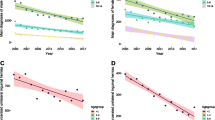Abstract
Purpose
In 2011 the local clinical commissioning group introduced a policy restricting funding for elective hernia repairs. Anecdotally, it was felt that this resulted in an increased number of emergency hernia repairs in our trust. Our primary objective was to assess whether this was actually the case. Our secondary objective was to quantify the risks of non-elective hernia repair.
Methods
We performed a retrospective cohort study, analysing all hernia surgeries performed between 2010 and 2013. The data were obtained from the trust Patient Information System. A total of 2556 patients underwent repair of inguinal, umbilical, incisional, femoral or ventral hernias over this time.
Results
As the policy intended, the number of elective hernia repairs reduced from 857 over 12 months before the funding restrictions to 606 in the same period afterwards (p < 0.001). Over the same time period, however, a significant rise in total emergency hernia repairs was demonstrated, increasing from 98 to 150 (p < 0.001). 30-day readmission rates also increased from 5.1 % before the policy introduction to 8.5 % afterwards (p = 0.006). In our data, the rate of bowel resection rises from 0.97 to 12.9 % for emergency operation compared to elective hernia repair (p < 0.001), while the median length of stay rises from less than 24 h to 3 days.
Conclusions
Our data suggest that the funding restrictions introduced in 2011 were followed by a statistically significant and unintended increase in emergency hernia repairs in our trust, with associated increased risks to patient safety.
Similar content being viewed by others
References
Team QRC, Gray M, Swift S, Suleman M, Beasley N, Hakes D, Qualie M, Mitchell A, Dutch S. Value based clinical commissioning of elective surgical care. http://www.rightcare.nhs.uk/wp-content/uploads/2011/12/Right_Care_Elective_Surgery_Phase1_report.pdf
Lacoboucci G (2013) GPs put the squeeze on access to hospital care. BMJ 347:f4351
Lee H, Beales S, Kinross J, Burns E, Darzi A (2013) The extent of rationing of surgical procedures in England. Lancet 381(9866):534–535
NHS Bristol, North Somerset and South Gloucestershire. Hernia management and repair in adults. Policy Statement: Date of Issue: 1 November 2011
Gallegos NC, Dawson J, Jarvis M, Hobsley M (1991) Risk of strangulation in groin hernias. Br J Surg 78(10):1171–1173
Fitzgibbons RJ Jr, Giobbie-Hurder A, Gibbs JO, Dunlop DD, Reda DJ, McCarthy M Jr, Neumayer LA, Barkun JS, Hoehn JL, Murphy JT, Sarosi GA Jr, Syme WC, Thompson JS, Wang J, Jonasson O (2006) Watchful waiting vs repair of inguinal hernia in minimally symptomatic men: a randomized clinical trial. JAMA 295(3):285–292
O’Dwyer PJ, Norrie J, Alani A, Walker A, Duffy F, Horgan P (2006) Observation or operation for patients with an asymptomatic inguinal hernia: a randomized clinical trial. Ann Surg 244(2):167–173
Bay-Nielsen M, Kehlet H, Strand L, Malmstrøm J, Andersen FH, Wara P, Juul P, Callesen T, Collaboration Danish Hernia Database (2001) Quality assessment of 26,304 herniorrhaphies in Denmark: a prospective nationwide study. Lancet 358(9288):1124–1128
Alvarez JA, Baldonedo RF, Bear IG, Solís JA, Alvarez P, Jorge JI (2004) Incarcerated groin hernias in adults: presentation and outcome. Hernia 8(2):121–126
Kulah B, Kulacoglu IH, Oruc MT, Duzgun AP, Moran M, Ozmen MM, Coskun F (2001) Presentation and outcome of incarcerated external hernias in adults. Am J Surg 181(2):101–104
Kulah B, Duzgun AP, Moran M, Kulacoglu IH, Ozmen MM, Coskun F (2001) Emergency hernia repairs in elderly patients. Am J Surg 182(5):455–459
Hwang MJ, Bhangu A, Webster CE, Bowley DM, Gannon MX, Karandikar SS (2014) Unintended consequences of policy change to watchful waiting for asymptomatic inguinal hernias. Ann R Coll Surg Eng 96:343–347
Barber JA, Thompson SG (2000). Analysis of cost data in randomized trials: an application of the non-parametric bootstrap. Stat Med 9:3219–3236
Chung L, Norrie J, O’Dwyer PJ (2011) Long-term follow-up of patients with a painless inguinal hernia from a randomized clinical trial. Br J Surg 98(4):596–599
Author information
Authors and Affiliations
Corresponding author
Ethics declarations
Funding
No sources of funding to declare.
Conflict of interest
No conflict of interest.
Rights and permissions
About this article
Cite this article
Orchard, M.R., Wright, J.A., Kelly, A. et al. The impact of healthcare rationing on elective and emergency hernia repair. Hernia 20, 405–409 (2016). https://doi.org/10.1007/s10029-015-1441-y
Received:
Accepted:
Published:
Issue Date:
DOI: https://doi.org/10.1007/s10029-015-1441-y




